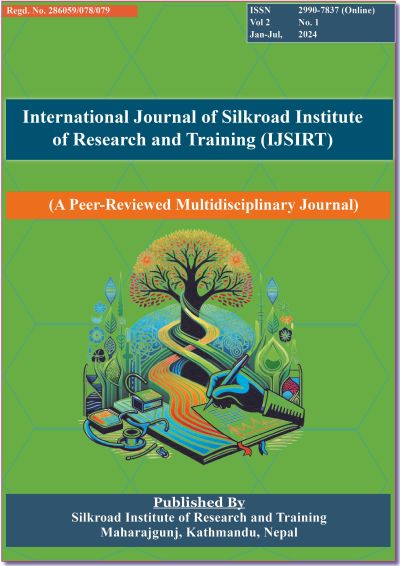Dental Carries Prevalence and Associated Factors of Secondary Level Students in Eastern Nepal
DOI:
https://doi.org/10.3126/ijsirt.v1i2.68460Abstract
Background: Dental caries or a tooth decay is a common oral health condition characterized by demineralization of
tooth enamel and subsequent formation of cavities It is a global public health problem and influence the overall health of
children.
Method: A cross-sectional study was conducted among 343 secondary level school students by complete enumeration
sampling method. A pretested, standardized, closed-ended questionnaire and a standard Decayed, Missing, and Filled
primary Teeth (DMFT) tools were adopted to find out the prevalence and associated factors of Dental Caries. Face to face
interview and oral assessment under natural day light were uses for data collection methods. Data were coded, entered,
cleaned and analyzed by using SPSS version 22. Descriptive and bi-variate statistics were employed to test the association
between dependent and independent variables. P-value less than 0.05 was taken as significant association and result was
presented in text, tables and graph.
Result: The overall prevalence of dental caries was 68.5% with a mean and SD of DMFT of 1.53±1.462 and female
students were most sufferer (70.1%) from dental caries. There was a significant association of dental caries with mother’s
educational status (p=0.009), consumption of sugary tea/coffee (p=<0.001), frequency of soft drinks consumption
(p=0.004), frequency of tooth brushing (p=<0.001) and changing time of new tooth brush (p=<0.001).
Conclusion: The study found a high prevalence of dental caries among the students, which were attributed to consumption
of sugary foods and drinks and poor oral hygiene practices. The researchers hold a strong conviction that relevant authorities
can provide the necessary actions to raise the awareness regarding the issue.
Downloads
Downloads
Published
How to Cite
Issue
Section
License
Copyright (c) 2024 Kajol Bhujel, Jiwan Kumar Poudyal, Sumitra Parajuli, Pratikshya Gaire, Hari Prasad Upadhyay

This work is licensed under a Creative Commons Attribution-ShareAlike 4.0 International License.
CC BY-SA: This license allows reusers to distribute, remix, adapt, and build upon the material in any medium or format, so long as attribution is given to the creator. The license allows for commercial use. If you remix, adapt, or build upon the material, you must license the modified material under identical terms.




